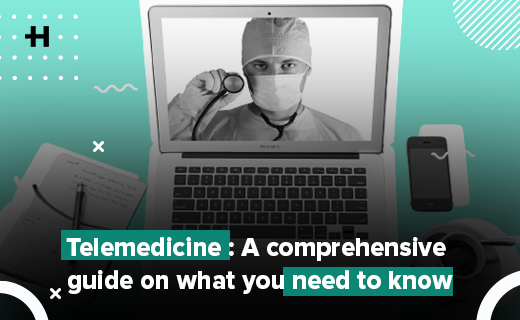In recent years, telemedicine has revolutionized the way healthcare services are delivered. Telemedicine allows patients to access healthcare services from the comfort and privacy of their own homes, providing convenient and accessible healthcare services. From routine check-ups to chronic disease management, telemedicine has expanded the range of healthcare services that can be provided remotely.
In this comprehensive guide to telemedicine, we will explore the benefits and challenges of telemedicine, how to access telemedicine services, and the various applications of telemedicine. We will also address common concerns about telemedicine, such as privacy and cost, and highlight the ways in which telemedicine is transforming healthcare delivery.
Whether you are a patient looking for convenient and accessible healthcare services or a healthcare provider looking to expand your services, this guide will provide valuable insights into the world of telemedicine. So, sit back, relax, and discover the exciting world of telemedicine.
Table of Contents
What is Telemedicine?
Telemedicine is the practice of providing remote healthcare services using telecommunication and information technologies such as video conferencing, mobile applications, and other digital communication tools. Telemedicine enables healthcare professionals to diagnose, treat, and monitor patients remotely. This service delivery model is especially useful for people living in remote areas where access to healthcare services is limited.

Types of Telemedicine
Telemedicine is a broad term that refers to the use of technology to provide healthcare services remotely. There are mainly 4 types of telemedicine that are used to deliver healthcare services to patients:- real-time, store-and-forward, remote patient monitoring & mobile health.
Real-Time Telemedicine
Real-time telemedicine, also known as live video conferencing, allows healthcare providers to communicate with patients in real-time using video conferencing technology. Real-time telemedicine is often used for virtual visits, consultations, and follow-up appointments.
Real-time telemedicine allows healthcare providers to provide remote diagnosis, monitoring, and treatment for patients. This type of telemedicine is particularly beneficial for patients who live in remote or underserved areas, as well as those who have difficulty accessing healthcare services in person.
Store-and-Forward Telemedicine
Store-and-forward telemedicine involves the collection and transmission of patient data, such as medical images, videos, and test results, to healthcare providers for review at a later time. This type of telemedicine is often used for diagnostic and screening purposes.
Store-and-forward telemedicine allows healthcare providers to review patient data at their convenience, reducing the need for in-person visits and improving efficiency. This type of telemedicine is often used for specialty consultations, such as dermatology or radiology.
Remote Patient Monitoring
Remote patient monitoring involves the use of technology to monitor patients’ health and wellbeing remotely. This type of telemedicine is often used for patients with chronic conditions, such as diabetes or heart disease.
Remote patient monitoring devices, such as blood pressure monitors or glucose monitors, are used to collect patient data and transmit it to healthcare providers for review. Healthcare providers can use this data to monitor patients’ conditions and adjust treatment plans as necessary.
Mobile Health
Mobile health, also known as mHealth, involves the use of mobile devices, such as smartphones or tablets, to deliver healthcare services to patients. This type of telemedicine is often used for patient education, medication reminders, and remote consultations.
Mobile health allows patients to access healthcare services from the convenience of their own devices, reducing the need for in-person visits and improving accessibility to healthcare services.
Benefits of Telemedicine
- Increased Access to Care: Telemedicine has improved access to healthcare services, especially for patients living in rural or remote areas. Patients no longer have to travel long distances to see a doctor or specialist, which can be challenging for those with mobility issues or those who live in areas without adequate transportation.
- Improved Patient Outcomes: Studies have shown that telemedicine can improve patient outcomes, including reduced hospital readmissions, improved management of chronic conditions, and improved patient satisfaction. Telemedicine can also provide patients with more timely access to care, which can be especially critical in emergencies.
- Improved Provider Efficiency: Telemedicine can improve provider efficiency by allowing healthcare providers to see more patients in less time. This is because telemedicine can reduce wait times and eliminate the need for providers to spend time on administrative tasks associated with traditional in-person appointments.
- Increased Patient Engagement: Telemedicine can increase patient engagement by allowing patients to take a more active role in their healthcare. Patients can receive real-time feedback on their health status, which can motivate them to make positive lifestyle changes and follow their treatment plans more closely.
- Improved Health Equity: Telemedicine can help address health disparities by increasing access to care for underserved populations, including those living in rural or remote areas, those with disabilities, and those with limited transportation options.
- Control of Infectious Illness: Telemedicine provides an effective way to help prevent the spread of infectious diseases, such as COVID-19 and the flu. With telehealth appointments, doctors can prescreen patients for possible infectious disease without the need for in-person visits, reducing the risk of exposure to other people’s germs. This is especially beneficial for individuals who are chronically ill, pregnant, elderly, or immunocompromised.
- Better Assessment: Telemedicine allows specialty practitioners to assess patients in their home environment, providing a more accurate diagnosis and treatment plan. For example, allergists can identify potential allergens in a patient’s home surroundings that may be contributing to their allergies. Additionally, neurologists and physical and occupational therapists can observe patients and assess their ability to navigate and take care of themselves in their home environment.
- Family Connections: Telemedicine can involve family members in the virtual visit, which can be especially helpful for patients who require assistance with communication or note-taking. Family members who live far away can also participate in the visit, providing additional support to patients and improving their overall care.
- Primary Care and Chronic Condition Management: Telemedicine allows patients to connect with primary care practitioners, such as family medicine specialists, internal medicine specialists, and pediatricians, easily and efficiently. Regular visits with these practitioners are essential for the management of chronic conditions, and telemedicine appointments can save time for both patients and practitioners.
- Increased Convenience: Telemedicine provides a convenient alternative to in-person appointments, particularly for individuals who live far away from healthcare facilities or have mobility issues. Patients can schedule appointments from the comfort of their own homes, eliminating the need to travel to appointments and reducing wait times.
- Reduced Healthcare Costs: Telemedicine can significantly reduce healthcare costs, particularly for individuals who require frequent visits with healthcare practitioners. Patients can save on transportation costs, and healthcare practitioners can save on overhead costs associated with maintaining a physical office space.
- Improved Access to Specialty Care: Telemedicine can improve access to specialty care for patients living in remote or underserved areas. With telemedicine, patients can connect with specialists who may not be available in their local area, which can be especially important for patients with rare or complex medical conditions. Additionally, telemedicine allows for more frequent check-ins and follow-ups with specialists, leading to improved patient outcomes.
Challenges of Telemedicine
Technology Barriers
One of the significant challenges of telemedicine is technology barriers. Patients and healthcare providers need access to reliable internet connections and appropriate devices to participate in telemedicine services. Patients who lack the necessary technology may find it difficult to access telemedicine services, limiting their access to healthcare.
Privacy and Security Concerns
Privacy and security concerns are another significant challenge of telemedicine. Patient information transmitted through telemedicine platforms must be secure to protect patient privacy. Healthcare providers must adhere to strict security protocols to ensure that patient information is not compromised.
Reimbursement Issues
Reimbursement issues are also a significant challenge of telemedicine. Currently, reimbursement policies for telemedicine services vary widely between insurance providers and states. This can create confusion for healthcare providers and limit the availability of telemedicine services for patients.
Legal and Regulatory Issues
Legal and regulatory issues can also pose a challenge for telemedicine. The practice of telemedicine is subject to state and federal regulations, which can be complex and confusing. Healthcare providers must ensure that they are complying with all relevant regulations to avoid legal issues.

Telemedicine: The Future of Healthcare
Telemedicine is transforming healthcare in numerous ways, providing patients with increased access to healthcare services, improving the quality of care, and reducing healthcare costs. The COVID-19 pandemic has accelerated the adoption of telemedicine, with many healthcare providers shifting to telemedicine to continue providing healthcare services during the pandemic.
Telemedicine is expected to continue growing in popularity and adoption, with significant potential to transform healthcare delivery. As technology continues to evolve, telemedicine will become more sophisticated and capable of providing even more comprehensive healthcare services remotely.
The Risks of Telemedicine
While telemedicine has many benefits, there are also some risks to consider. One of the main risks is the potential for misdiagnosis or missed diagnoses, as healthcare providers may not be able to conduct a physical examination. This is particularly true for patients with complex medical conditions, who may require in-person assessments.
There is also a risk of technical difficulties, which could prevent patients from accessing healthcare services when they need them. This could be due to issues with the telemedicine platform or problems with internet connectivity. It is important to ensure that patients have access to technical support and troubleshooting resources to minimize the risk of technical difficulties.
Another risk to consider is the potential for privacy breaches. Telemedicine involves the transfer of sensitive medical information over the internet, which could be vulnerable to cyberattacks or other security breaches. It is important to use secure telemedicine platforms and to follow best practices for protecting patient data.
Telemedicine Applications
Telemedicine has a wide range of applications across various medical specialties, including:
| APPLICATIONS | DEFINITION |
| Teleconsultation | Teleconsultation involves the use of video conferencing tools to allow patients to consult with a healthcare provider remotely. |
| Telemonitoring | Telemonitoring enables healthcare providers to remotely monitor patients’ health status, including vital signs such as blood pressure, heart rate, and oxygen saturation levels. |
| Telepsychiatry | Telepsychiatry involves the use of telemedicine to provide mental health services remotely. |
| Telestroke | Telestroke involves the use of telemedicine to diagnose and treat stroke patients remotely. |
| TeleICU | TeleICU involves the use of telemedicine to remotely monitor patients in the intensive care unit. |
How to Access Telemedicine Services
Accessing telemedicine services is simple and straightforward. Here’s how to get started:
Step 1: Research Telemedicine Providers
Research telemedicine providers in your area or online. You can start by checking with your primary care provider or insurance provider to see if they offer telemedicine services. You can also search online for telemedicine providers in your area.
Step 2: Choose a Telemedicine Provider
Once you have identified telemedicine providers in your area, research and compare them. Consider factors such as the types of services offered, availability, cost, and insurance coverage.
Step 3: Schedule an Appointment
Once you have chosen a telemedicine provider, schedule an appointment. Some telemedicine providers offer online scheduling, while others may require you to call or email to schedule an appointment.
Step 4: Prepare for Your Appointment
Before your appointment, make sure you have access to the necessary technology and equipment, such as a device with a camera and microphone and a reliable internet connection. Also, make sure you have your medical history and any relevant medical information readily available.
Step 5: Attend Your Appointment
Attend your appointment at the scheduled time. Be prepared to answer questions about your symptoms and medical history. Depending on the type of service, your healthcare provider may ask you to perform certain tasks, such as taking your blood pressure or checking your temperature.
Don’t let distance or accessibility prevent you from receiving the healthcare services you need. Join Healthysure and experience the convenience and benefits of telemedicine today!
Telemedicine and Mental Health
Telemedicine is not just for physical health services; it is also a valuable resource for mental health services. Telemedicine provides patients with access to mental health services from the comfort and privacy of their homes, making it a convenient and accessible option for those who may be hesitant to seek in-person care.
Telemedicine can be used for a range of mental health services, including therapy, counseling, and medication management. It allows patients to connect with licensed mental health professionals through video conferencing, phone calls, or messaging platforms.
Telemedicine and Chronic Disease Management
Telemedicine is also a valuable resource for chronic disease management. Patients with chronic diseases, such as diabetes or heart disease, require frequent monitoring and management to ensure that their conditions are under control. Telemedicine allows healthcare providers to monitor patients’ conditions remotely, reducing the need for frequent in-person visits.
Through telemedicine, healthcare providers can monitor patients’ vital signs, review medication regimens, and provide education and support. This allows patients to better manage their conditions and improve their overall health outcomes.
Telemedicine and Preventive Care
Telemedicine can also be used for preventive care services, such as annual check-ups and screenings. Telemedicine allows patients to connect with healthcare providers remotely, reducing the need for in-person visits.
Through telemedicine, healthcare providers can perform routine screenings, such as mammograms and colonoscopies, and provide education and counseling on healthy lifestyle habits. This allows patients to stay on top of their preventive care needs and reduce their risk of developing chronic diseases.
Telemedicine and COVID-19
The COVID-19 pandemic has accelerated the adoption of telemedicine, with many healthcare providers shifting to telemedicine to continue providing healthcare services during the pandemic. Telemedicine has played a crucial role in reducing the spread of COVID-19 by reducing the number of in-person visits and allowing healthcare providers to screen patients remotely.
Telemedicine has also played a crucial role in providing healthcare services to patients who are quarantined or in isolation. It allows healthcare providers to monitor patients’ conditions remotely, reducing the risk of exposure to the virus.
Telemedicine and Pediatric Care
Telemedicine is also valuable for pediatric care, providing children and their families with convenient and accessible healthcare services. Telemedicine allows healthcare providers to monitor children’s health and development remotely, reducing the need for frequent in-person visits.
Telemedicine is particularly beneficial for children with chronic conditions, such as asthma or diabetes. It allows healthcare providers to monitor their conditions and adjust treatment plans as necessary, reducing the risk of complications and improving overall health outcomes.
Telemedicine can also be used for behavioral and developmental screenings, allowing healthcare providers to identify and address any concerns early on. This can help to ensure that children receive appropriate care and support for their physical, emotional, and social development.
Telemedicine and Women’s Health
Telemedicine is also beneficial for women’s health services, providing convenient and accessible healthcare services for women. Telemedicine allows women to access healthcare services from the comfort and privacy of their own homes, reducing the need for in-person visits.
Telemedicine can be used for a range of women’s health services, including prenatal care, postpartum care, and family planning. It allows healthcare providers to monitor women’s health remotely and provide appropriate care and support.
Telemedicine can also be used for breast and cervical cancer screenings, allowing women to receive routine screenings and follow-up care without the need for in-person visits.
Telemedicine and Rural Healthcare
Telemedicine is particularly beneficial for rural healthcare, where patients may have limited access to healthcare services. Telemedicine allows healthcare providers to reach patients in remote and underserved areas, improving access to healthcare services and reducing healthcare disparities.
Telemedicine has also helped to address the shortage of healthcare providers in rural areas. By providing remote healthcare services, healthcare providers can treat more patients in a shorter amount of time, reducing the workload for healthcare providers in rural areas.
Telemedicine and Emergency Response
Telemedicine can also be used in emergency response situations, such as natural disasters or pandemics. Telemedicine allows healthcare providers to provide remote healthcare services in areas that are inaccessible or unsafe for in-person visits.
Telemedicine can also be used to triage patients in emergency situations, allowing healthcare providers to identify and prioritize patients who require immediate attention. This can help to reduce the strain on emergency rooms and ensure that patients receive timely and appropriate care.
Telemedicine and Home Health
Telemedicine is also beneficial for home health services, allowing healthcare providers to monitor patients’ conditions remotely and provide appropriate care. Telemedicine allows healthcare providers to communicate with patients and their caregivers, provide education and support, and monitor patients’ medication regimens and vital signs.
Through telemedicine, healthcare providers can also coordinate care with other healthcare providers, such as physical therapists and home health aides, improving overall health outcomes and reducing healthcare costs.
How Healthysure Can Help?
At Healthysure, we understand the importance of accessible and affordable healthcare services for employees. That’s why we offer a comprehensive employee benefits platform that includes telemedicine services.
Our telemedicine services provide convenient and accessible healthcare services for employees, allowing them to connect with healthcare providers remotely from the comfort and privacy of their own homes.
Our telemedicine services are covered by most insurance providers, reducing healthcare costs for both employers and employees. Our platform is also easy to use, with simple scheduling and appointment booking features.
In addition to telemedicine services, our employee benefits platform includes a range of other healthcare services, including preventive care services, mental health services, and chronic disease management programs.
At Healthysure, we are committed to providing high-quality healthcare services to employees, improving overall health outcomes and reducing healthcare costs. Contact us today to learn more about our employee benefits platform and how we can help your employees access the healthcare services they need.
Conclusion
Telemedicine is transforming healthcare delivery, providing patients with convenient, accessible, and high-quality healthcare services. From mental health services to chronic disease management, telemedicine is expanding the range of services that can be provided remotely.
Despite some challenges, such as privacy concerns and insurance coverage, the benefits of telemedicine far outweigh the challenges. Telemedicine has become even more important during the COVID-19 pandemic, reducing the risk of exposure to the virus and providing healthcare services to those who are quarantined or in isolation.
Telemedicine is also addressing healthcare disparities by providing healthcare services to underserved areas and reducing the workload for healthcare providers in rural areas. It is improving overall health outcomes, reducing healthcare costs, and increasing accessibility to healthcare services for patients.
As technology continues to evolve, telemedicine will become even more comprehensive and capable of providing high-quality care wherever patients are. So, if you are looking for a convenient and accessible option for healthcare services, consider telemedicine. It is a game-changer that is making healthcare services available to more people than ever before.
FAQs
What is telemedicine?
Telemedicine is the practice of delivering healthcare services remotely using technology, such as video conferencing, phone calls, or messaging platforms.
What types of services can be provided through telemedicine?
Telemedicine can be used for a range of healthcare services, including mental health services, chronic disease management, preventive care services, pediatric care, and women’s health services.




